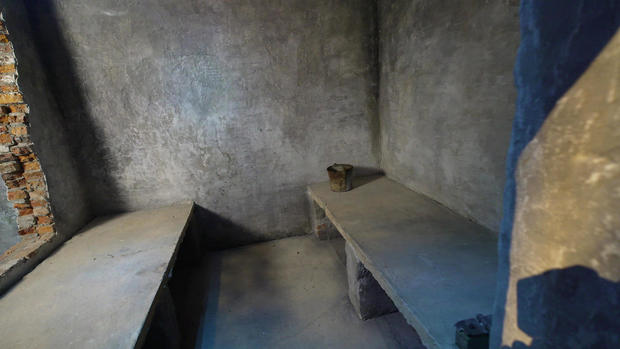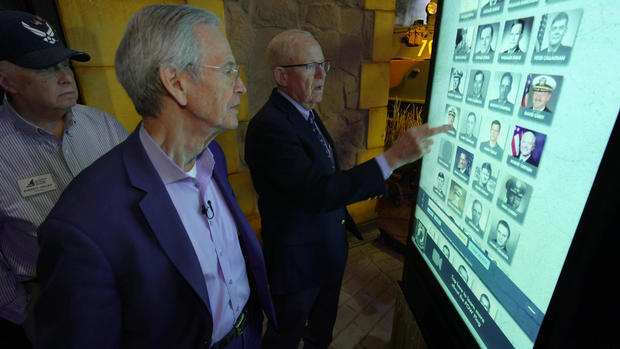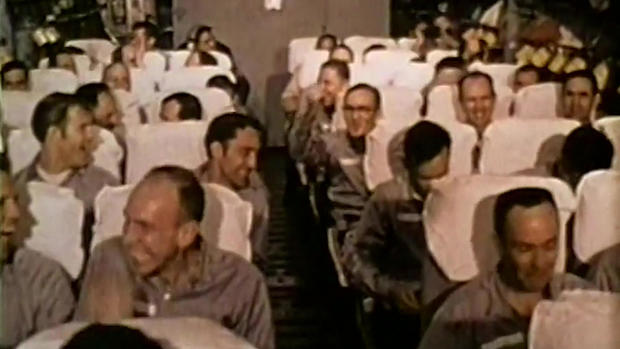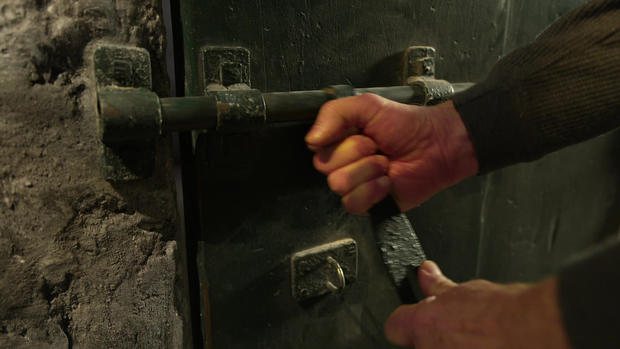Mike McGrath was a 27-year-old Navy pilot when he was shot down over North Vietnam and taken to a prison in Hanoi – what the POWs sarcastically called the “Hanoi Hilton.” Part of the prison, salvaged when the building was torn down, is now on display at the American Heritage Museum outside Boston.
Peering into a recreated cell through a prison door hatch, McGrath said, “This is where the guards could check on you, and they’d harass you day and night.”
Inside McGrath exclaimed, “Oh, my God, that’s a cement slab. That is my mattress and my bed for years.
“This is very real,” he said.
CBS News
It’s been more than 50 years since Operation Homecoming brought the prisoners back to the United States, and only a handful of the surviving POWs could make it for the opening of the exhibit. Just turned 80, Charlie Plumb is one of the youngest. “It is a fraternity like no other,” he said. “When you got guys that saved your life and they say that you saved their life, you have a bond like no other.”
The exhibit tells their harrowing stories, such as that of the late James Stockdale, who received the Medal of Honor for his courage in captivity. “I think most of the guys would tell you that this guy saved our life,” said Plumb. “Just the best leader I’ve ever seen. And he said, ‘We’ve got a war to fight. We are warriors. We will pursue this war ’til our last dying breath.'”
CBS News
Robert Shumaker, who was shot down in 1965, said, “You’re on top of the world, flying this fighter that could go a thousand miles an hour, you know? You’re invincible. And there you are on the ground, you know, and reduced to almost being an animal.”
Often injured when they bailed out, the pilots were abused by angry villagers, given crude medical care, and held under not just harsh, but cruel conditions.
Shumaker showed Martin leg irons that were applied to those who “misbehaved.” “They’d lock your ankles in here,” he said.
“How long would they leave you in those things?” Martin asked.
“I was in it for, I think, maybe two or three weeks or so.”
CBS News
And worse, much worse, awaited them in a place called the Knobby Room – the torture room where the Vietnamese would try to extract information from the prisoners. “I was tortured 12 times,” Shumaker said.
Drawings by Mike McGrath show us exactly what that torture looked like. “They put your arms behind your back and they’ll cinch up your elbows until your ribs start pulling apart here,” McGrath said. “Then they rotate over your head until your shoulder dislocates, and no man can stand the pain.”
Mike McGrath
Shumaker noted, “They ran a metal bar down my throat to keep me from screaming.”
What were they trying to get out of you? Shumaker said, “They just wanted to get propaganda statements out of us, about how we (according to them) bombed churches and pagodas and all kinds of things, which was untrue.”
McGrath said, “No man stuck to name, rank, serial number. Impossible. We all had guilt feelings that we broke a bond with the United States and gave information, whether false or true.”
Martin asked, “Do you remember when you broke?”
“Oh yeah,” he replied. “I remember my arm going out of place, and I said, Oh, I got to tell them something. I can’t stand this. I started telling them lies, half-truths.”
“So, where’s the guilt in that?”
“You felt you let your country down by not just holding on and dying,” McGrath replied.
The only defense against the pain and guilt was finding a way to talk to each other, by tapping in code through stone walls.
Martin asked, “How important was communication?”
“Communication was the key to our life,” said McGrath. “Communication gave us the strength, the organization, the leadership, the inspiration to continue to resist.”
CBS News
When Jeremiah Denton was trotted out for a photo op, he told the world what was really going by blinking out the word T-O-R-T-U-R-E in Morse code; while Richard Stratton put on an over-the-top show of being brainwashed. “That was our fight in the prison camp,” said Charlie Plumb. “We didn’t have our airplanes anymore, or we didn’t have guns to fight with. We were going to fight to try to deny them the propaganda.”
There were attempts to escape, but none succeeded. Ed Atterbury was beaten to death after he was caught. “I heard him go out the ceiling that night,” McGrath recalled, “and we said, ‘Well, the torture starts tomorrow.’ And we were right. They came in and tortured everybody in the camp.”
McGrath was beaten within an inch of his life. He showed Martin a drawing of himself being beaten with a fan belt.
Mike McGrath
“They wanted to know who was involved in the escape,” he said. “I still remember that.”
When North Vietnam’s leader Ho Chi Minh died in 1969, the torture stopped, and the North switched its propaganda to make the Hanoi Hilton look like a summer camp.
Then, one day in 1973 the prisoners were lined up in a courtyard and told they would be released. Not ready to believe it, they showed no emotion. But they were given fresh clothes and put on buses for the airport, where it became real.
The late Jeremiah Denton recalled the moment in an Air Force interview: “An American plane at close range with the American flag on it. U.S. Air Force. And American military uniformed personnel 50 to 100 yards from us? You don’t know the feeling it gave me, and I’m sure everybody else.”
As their former tormenter, a man they called “Rabbit,” looked on, each POW, including John McCain, came a few steps closer to freedom. Emotions were building, and then it was “wheels up.”
CBS News
When they landed in the Philippines, Denton was first off. “We are honored to have had the opportunity to serve our country under difficult circumstances,” he said.
For Shumaker, it had been eight years and one day in Hell. He told Martin, “To this day, if I hear somebody jingling keys, I mean, my heart rate goes up, and you think they’re coming to torture somebody – and it’s gonna be me or the guy next door.”
CBS News
Four-hundred-and-ninety-three men the North Vietnamese called “air pilots” were captured in North Vietnam. Twenty-eight died in prison.
The rest came home.
For more info:
Story produced by Mary Walsh. Editor: Joseph Frandino.
See also:
Stay connected with us on social media platform for instant update click here to join our Twitter, & Facebook
We are now on Telegram. Click here to join our channel (@TechiUpdate) and stay updated with the latest Technology headlines.
For all the latest Education News Click Here








